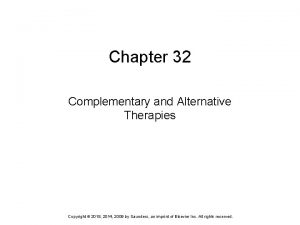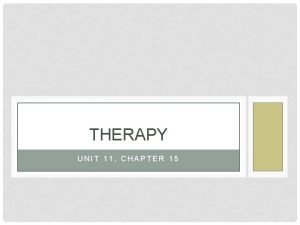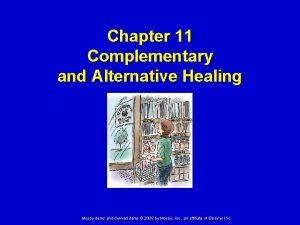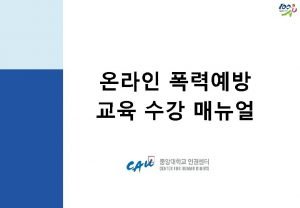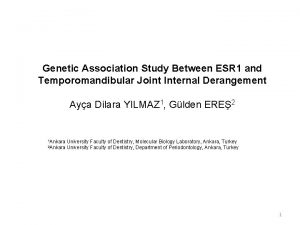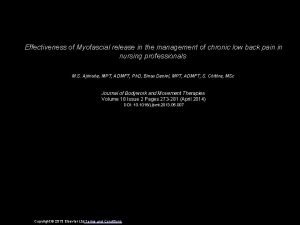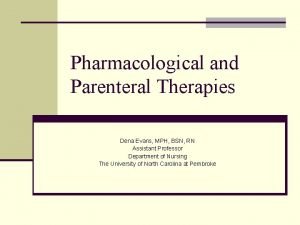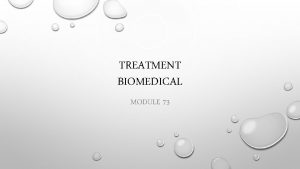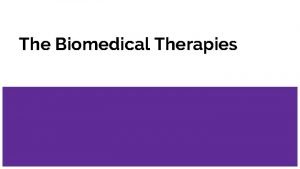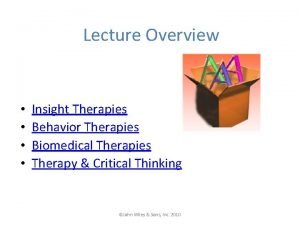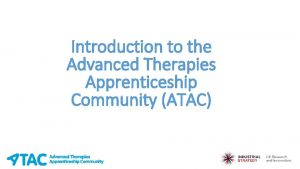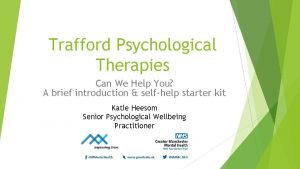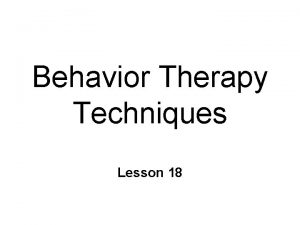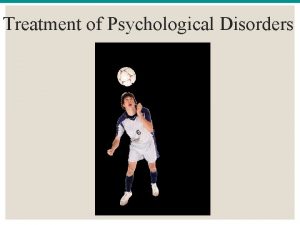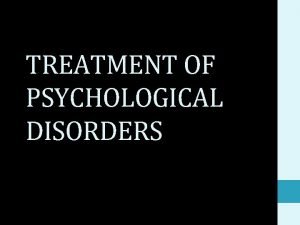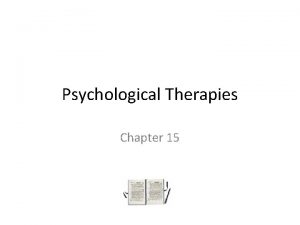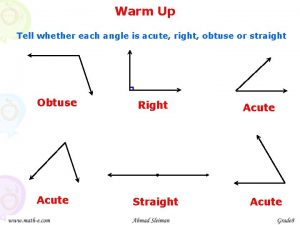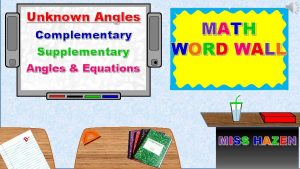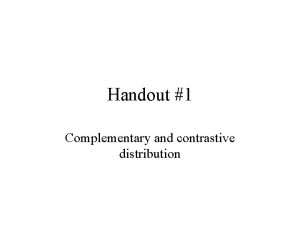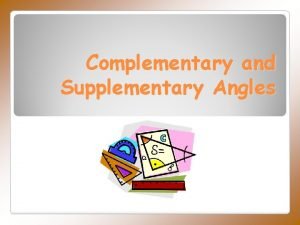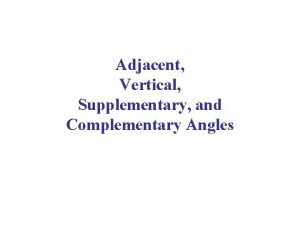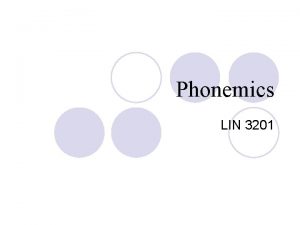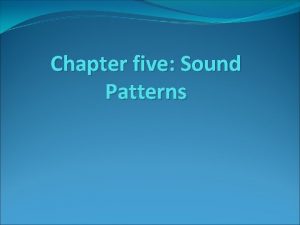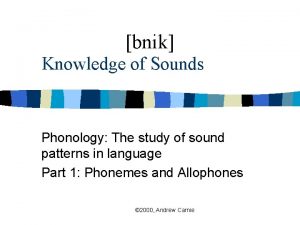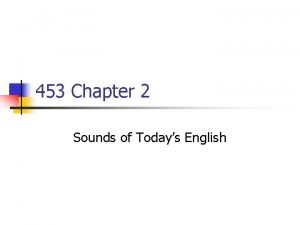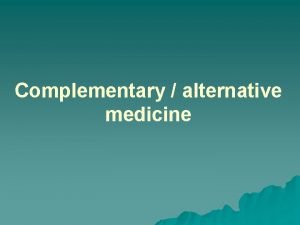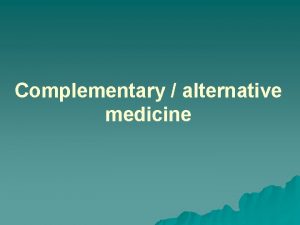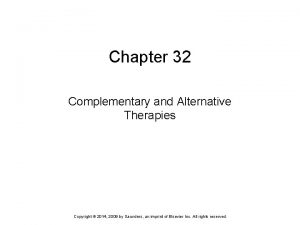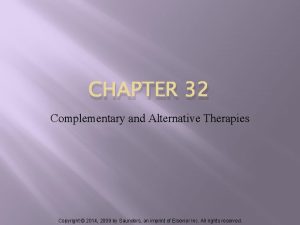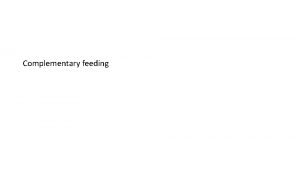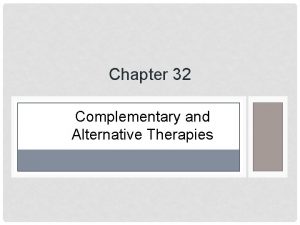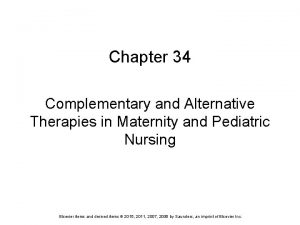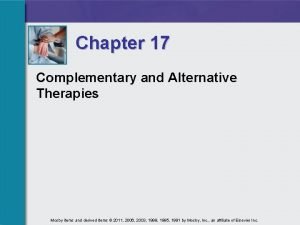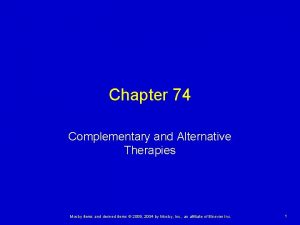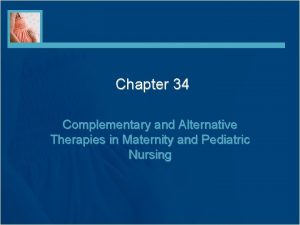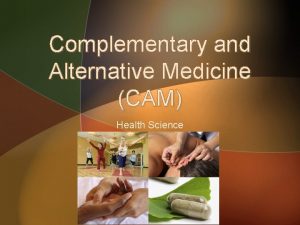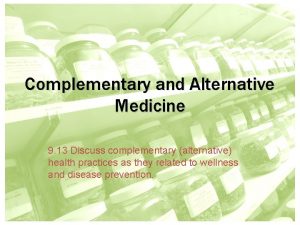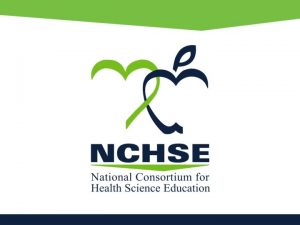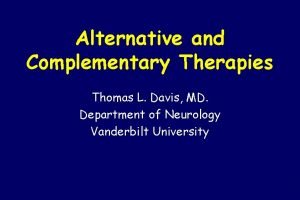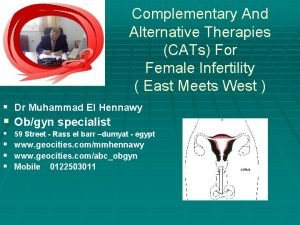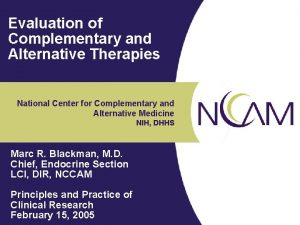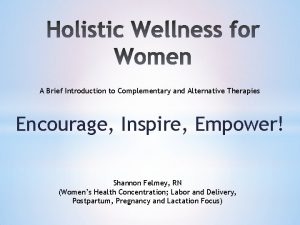Chapter 32 Complementary and Alternative Therapies Copyright 2018



































- Slides: 35

Chapter 32 Complementary and Alternative Therapies Copyright © 2018, 2014, 2009 by Saunders, an imprint of Elsevier Inc. All rights reserved.

Lesson 32. 1 Complementary Medicine Overview Theory 1) Discuss the use of complementary and alternative medicine (CAM) in integrative medicine. 2) Consider each therapy that is considered a part of CAM. 3) Examine five commonly used complementary and alternative therapies. 4) Contrast four mind-body therapies. Clinical Practice 1) Assist patients in using relaxation and imagery. Copyright © 2018, 2014, 2009 by Saunders, an imprint of Elsevier Inc. All rights reserved.

Complementary and Alternative Medicine Complementary therapies—used in conjunction with other medical treatments Alternative therapies—used in place of mainstream medicine Ø Example: macrobiotic diet therapy used to treat cancer instead of having surgery, radiation, or chemotherapy Copyright © 2018, 2014, 2009 by Saunders, an imprint of Elsevier Inc. All rights reserved.

Complementary and Alternative Medicine (cont’d) Many of the alternatives can be expensive and frequently are not covered by insurance. National Institute of Health’s National Center for Complementary and Integrative Health (NCCIH) was established to undertake evidence-based research regarding the efficacy of the various complementary and integrative health therapies, and to provide information for the public Copyright © 2018, 2014, 2009 by Saunders, an imprint of Elsevier Inc. All rights reserved.

Complementary and Alternative Medicine (cont’d) NCCIH classifies complementary therapies into two main categories: Mind and Body Interventions Ø Natural Products Ø Other Complementary Interventions: therapies do not fit in either of the two groups. These therapies include traditional healers, Ayurvedic medicine, traditional Chinese medicine, homeopathy, and naturopathy. Ø Copyright © 2018, 2014, 2009 by Saunders, an imprint of Elsevier Inc. All rights reserved.

Mind and Body Interventions: Acupuncture A branch of Chinese medicine in which needles are used to stimulate certain points on the body (called meridians to stimulate or disperse the flow of energy) Can be an effective method to control pain Also used to increase immunity Copyright © 2018, 2014, 2009 by Saunders, an imprint of Elsevier Inc. All rights reserved.

Mind-Body Interventions: Yoga A spiritual practice that combines exercise, controlled breathing, posture, and mental focus to bring about positive effects on the body and mind Effects Regulating blood pressure and heart rate Ø Increasing circulation Ø Aiding digestion Ø Healing chronic back pain Ø Helping with other disorders Ø Copyright © 2018, 2014, 2009 by Saunders, an imprint of Elsevier Inc. All rights reserved.

Figure 32 -2: Yoga Copyright © 2018, 2014, 2009 by Saunders, an imprint of Elsevier Inc. All rights reserved.

Mind and Body Interventions: Chiropractic Uses manipulation of the spine for symptomatic relief and improved functioning Brings the spinal components back into correct alignment, thereby decreasing or eliminating pain Exercise, ice, heat, electrical stimulation, and massage may be used in conjunction with spinal manipulation Copyright © 2018, 2014, 2009 by Saunders, an imprint of Elsevier Inc. All rights reserved.

Mind and Body Interventions: Massage therapy Uses soft tissue manipulation to improve health Stroking, kneading, friction, and vibration used to relieve muscle pain and promote comfort Copyright © 2018, 2014, 2009 by Saunders, an imprint of Elsevier Inc. All rights reserved.

Mind and Body Interventions: Relaxation Therapy Used to ease stress and is helpful for a variety of chronic illnesses Relaxation induces a light state of altered consciousness through refocusing, conscious breathing, and body awareness Copyright © 2018, 2014, 2009 by Saunders, an imprint of Elsevier Inc. All rights reserved.

Mind and Body Interventions: Imagery Uses a visual stimulus to produce a particular physiologic change that can decrease stress or promote healing Useful in decreasing pain, and can be particularly helpful to patients undergoing painful procedures Copyright © 2018, 2014, 2009 by Saunders, an imprint of Elsevier Inc. All rights reserved.

Mind and Body Interventions: Meditation Involves focusing attention on a single repetitive stimulus, thereby decreasing all other stimuli Alters consciousness and can bring a beneficial mind-body response Induces a restful state and lowers heart and respiratory rates; may reduce anxiety Copyright © 2018, 2014, 2009 by Saunders, an imprint of Elsevier Inc. All rights reserved.

Mind and Body Interventions: Biofeedback Technique that trains patient to lessen symptoms Learn to control particular internal physiologic processes that normally occur involuntarily, such as heart rate or blood pressure With practice, a person can use this information to gain control over the “involuntary” activity Copyright © 2018, 2014, 2009 by Saunders, an imprint of Elsevier Inc. All rights reserved.

Biofield Therapies Qi Gong A form of exercise (stimulation therapy) Ø Improves health by redirecting mental focus, controlling breathing, improving coordination, and promoting relaxation Ø Activates the natural currents that flow along the body’s meridians to rebalance the body’s own healing ability Ø Copyright © 2018, 2014, 2009 by Saunders, an imprint of Elsevier Inc. All rights reserved.

Biofield Therapies (con’t) Reiki A practitioner acts as a conduit for healing energy that is directed into the patient’s energy field or body Ø Channels energy to the patient, and the patient’s body does the healing Ø Therapeutic touch Alters body energy fields to restore natural healing powers Ø The hands of the practitioner are passed over the patient to ascertain where tensions or excessive energies exist Ø Touch may be used to redirect energies and reestablish energy balance Ø Copyright © 2018, 2014, 2009 by Saunders, an imprint of Elsevier Inc. All rights reserved.

Mind and Body Interventions: Hypnotherapy Used to alter behavior, retrieve memories, and induce anesthesia A hypnotic state is created in which suggestions are implanted that remain during the posthypnotic period Copyright © 2018, 2014, 2009 by Saunders, an imprint of Elsevier Inc. All rights reserved.

Mind and Body Interventions: Music, Art, and Dance Therapy Art therapy helpful when the person has difficulty expressing feelings verbally Music therapy beneficial for expressing feelings, reducing stress and anxiety, enhancing relaxation; also a distraction to aid in pain management Dance therapy promotes recognition of feelings and awareness of the body Copyright © 2018, 2014, 2009 by Saunders, an imprint of Elsevier Inc. All rights reserved.

Mind and Body Interventions: Humor Proven very helpful as complementary treatment Can speed the course of healing and decrease pain Generally will raise spirits and help to bring about a more positive outlook Copyright © 2018, 2014, 2009 by Saunders, an imprint of Elsevier Inc. All rights reserved.

Mind and Body Interventions: Prayer Helps reduce stress, promotes healing, and may arrest disease May be practiced individually or in groups as intercessory prayer Prayer chains Ø Different people pray for a set time for an individual’s recovery over a period of hours or days; considered beneficial by many people Copyright © 2018, 2014, 2009 by Saunders, an imprint of Elsevier Inc. All rights reserved.

Question 1 Sara’s patient is nervous about a painful procedure tomorrow. Her patient is using a visual stimulus to produce a particular physiologic change that can decrease stress or pain. Her patient is using which relaxing therapy? 1) 2) 3) 4) Imagery Meditation Biofeedback Hypnotherapy Copyright © 2018, 2014, 2009 by Saunders, an imprint of Elsevier Inc. All rights reserved.

Lesson 32. 2 Overview of Alternative Therapies Theory 5) Direct patients to information needed to make a decision on whether to use an herbal preparation. 6) Describe the desired outcome of spinal manipulation during chiropractic treatment. Clinical Practice 2) Assess the use of complementary and alternative therapies by assigned patients. 3) Direct patients to information about complementary and alternative therapies. Copyright © 2018, 2014, 2009 by Saunders, an imprint of Elsevier Inc. All rights reserved.

Natural Products: Herbal Therapy/Aromatherapy Herbal therapy Used by more than 70% of the world’s population Ø Medicines contain plants as their active ingredient Ø Used to treat a wide variety of conditions Ø Many herbs interact with prescription drugs Ø Aromatherapy Oils from plants absorbed through the skin or inhaled Ø Thought to act on the brain to evoke pleasant feelings related to past experiences and emotions Ø Copyright © 2018, 2014, 2009 by Saunders, an imprint of Elsevier Inc. All rights reserved.

Herbs Determined to Be Safe by Non -U. S. Authorities Aloe Astragalus Bilberry Cat’s claw Chamomile Dong quai Echinacea Feverfew Garlic Ginger Ginkgo biloba Ginseng Goldenseal Hawthorn Milk thistle St. John’s wort Saw palmetto Valerian Copyright © 2018, 2014, 2009 by Saunders, an imprint of Elsevier Inc. All rights reserved.

Other Complementary Interventions: Homeopathic Medicine Teaches that symptoms are signs of the body’s effort to get rid of disease Disease can be cured by giving small doses of substances that produce symptoms of the disease Stimulates a person’s natural defenses, alleviating the problem Three principles: Like cures like Ø The greater the dilution of the remedy, the greater its potency Ø Illness is specific to the individual Ø Copyright © 2018, 2014, 2009 by Saunders, an imprint of Elsevier Inc. All rights reserved.

Other Complementary Interventions: Naturopathic Medicine A philosophy directed at the prevention of disease Use of natural means to promote health Lifestyle management, natural foods, massage, used with regular exercise to maintain the body at a high level of wellness through use of the body’s inherent healing ability Copyright © 2018, 2014, 2009 by Saunders, an imprint of Elsevier Inc. All rights reserved.

Other Complementary Interventions: Traditional Chinese Medicine Based on opposition of polarities (yin/yang); the elements of wood, fire, earth, metal, and water; and the flow of energy (chi) in the body Focuses on looking for underlying causes of imbalance and patterns of disharmony in the body Uses medicinal plants, acupuncture, massage, Tai Chi, and Qi Gong for therapy Copyright © 2018, 2014, 2009 by Saunders, an imprint of Elsevier Inc. All rights reserved.

Other Complementary Interventions: Ayurveda The traditional Hindu system of medicine Uses combinations of herbs, minerals, purgatives, massage, meditation, special diets Focuses on restoring and strengthening the body, mind, and spirit Healing focus is on maintenance of balance and wholeness to prevent illness Copyright © 2018, 2014, 2009 by Saunders, an imprint of Elsevier Inc. All rights reserved.

Other Complementary Interventions: Shamanism The shaman uses techniques to achieve a nonordinary reality, or a “shamanic” state of consciousness May perform various ceremonies including burning particular plants and herbs to bring about the rebalancing of the individual with nature Copyright © 2018, 2014, 2009 by Saunders, an imprint of Elsevier Inc. All rights reserved.

Other Complementary Interventions: Folk Medicine A holistic approach to healing practiced throughout Latin America Illness is seen as an imbalance • Hot and cold • Patient and the environment • Parts of the body • Patient and the spiritual realm Ø Biologic compounds, foods, and herbs are used to treat the physical components of the illness Ø A curandero treats the supernatural components Ø Copyright © 2018, 2014, 2009 by Saunders, an imprint of Elsevier Inc. All rights reserved.

Other Complementary Interventions: Native American Medicine Healing herbs and ceremonies combined with a spiritual emphasis are used to treat ailing patients Therapies based on the belief that spirit, mind, and emotions all interact with the environment Patient’s disease or disorder is believed to be caused by a disharmony in the patient’s connection to nature and the spirit world Copyright © 2018, 2014, 2009 by Saunders, an imprint of Elsevier Inc. All rights reserved.

Question 2 Which type of complementary therapy is a form of Chinese exercise-stimulation therapy that is supposed to improve health by redirecting mental focus, controlling breathing, improving coordination, and promoting relaxation? 1) 2) 3) 4) Acupuncture Qi Gong Ayurveda Shamanism Copyright © 2018, 2014, 2009 by Saunders, an imprint of Elsevier Inc. All rights reserved.

Question 3 Peggy has a patient who verbalizes that she prefers to approach her illness in a holistic way. Which type of medicine uses this approach? 1) 2) 3) 4) Homeopathic Naturopathic Chinese Folk Copyright © 2018, 2014, 2009 by Saunders, an imprint of Elsevier Inc. All rights reserved.

Question 4 Chloe’s patient states, “I often use herbs when I am nauseated. ” Which herb would Chloe’s patient use? 1) 2) 3) 4) Echinacea Ginseng Ginger St. John’s wort Copyright © 2018, 2014, 2009 by Saunders, an imprint of Elsevier Inc. All rights reserved.

Question 5 Jim’s patient asks if there any herbs to shrink the prostate gland. Which of the following helps shrink the prostate gland? 1) 2) 3) 4) Hawthorn Milk thistle Saw palmetto Valerian Copyright © 2018, 2014, 2009 by Saunders, an imprint of Elsevier Inc. All rights reserved.
 Chapter 32 complementary and alternative therapies
Chapter 32 complementary and alternative therapies Alternative therapy ppt
Alternative therapy ppt Difference between psychoanalysis and psychodynamic
Difference between psychoanalysis and psychodynamic Chapter 11 complementary and alternative medicine
Chapter 11 complementary and alternative medicine Copyright © 2018
Copyright © 2018 Copyright © 2018 all rights reserved
Copyright © 2018 all rights reserved Que letra continua m v t m j
Que letra continua m v t m j Both psychoanalysis and humanistic therapy stress
Both psychoanalysis and humanistic therapy stress Bodywork and movement therapies
Bodywork and movement therapies Bodywork and movement therapies
Bodywork and movement therapies Pharmacological and parenteral therapies
Pharmacological and parenteral therapies Module 73: the biomedical therapies
Module 73: the biomedical therapies Biomedical therapies
Biomedical therapies Stiriti ayur therapies private limited
Stiriti ayur therapies private limited Talking therapies westminster
Talking therapies westminster Insight therapy definition
Insight therapy definition Advanced therapies apprenticeship community
Advanced therapies apprenticeship community Trafford psychological therapies
Trafford psychological therapies Acceleration behavioral therapies
Acceleration behavioral therapies Trafford iapt
Trafford iapt Humanistic therapies aim to boost
Humanistic therapies aim to boost What are biomedical therapies
What are biomedical therapies Blincyto fda
Blincyto fda Insight therapies involve verbal interactions
Insight therapies involve verbal interactions Trafford psychological therapies
Trafford psychological therapies Advantages of group therapy
Advantages of group therapy Trafford psychological therapies
Trafford psychological therapies Tell whether each type of angle
Tell whether each type of angle Complementary and supplementary angles formula
Complementary and supplementary angles formula Contrastive distribution in phonology
Contrastive distribution in phonology How to remember complementary and supplementary angles
How to remember complementary and supplementary angles Adjacent supplementary angles examples
Adjacent supplementary angles examples Free variation and complementary distribution
Free variation and complementary distribution Distinctive feature theory in phonology
Distinctive feature theory in phonology Allophones examples
Allophones examples Free variation and complementary distribution
Free variation and complementary distribution
